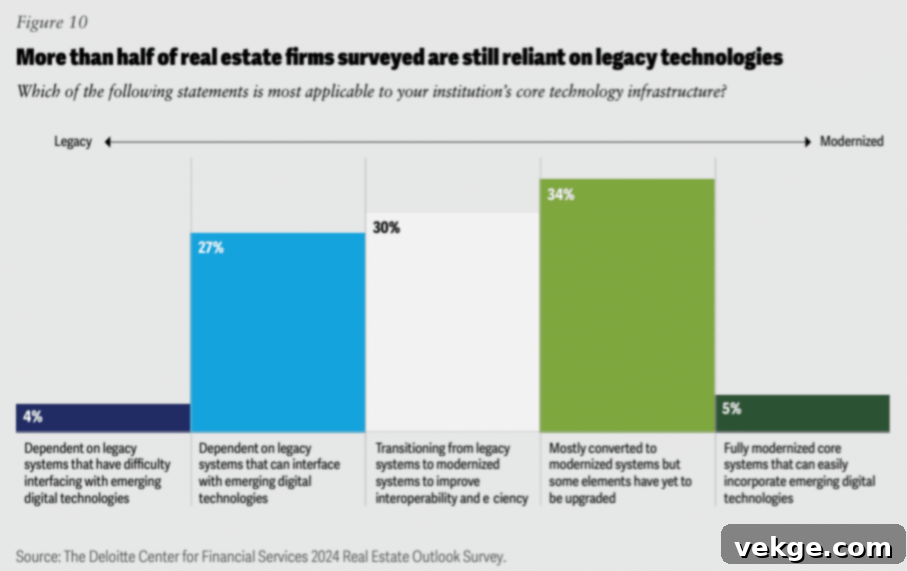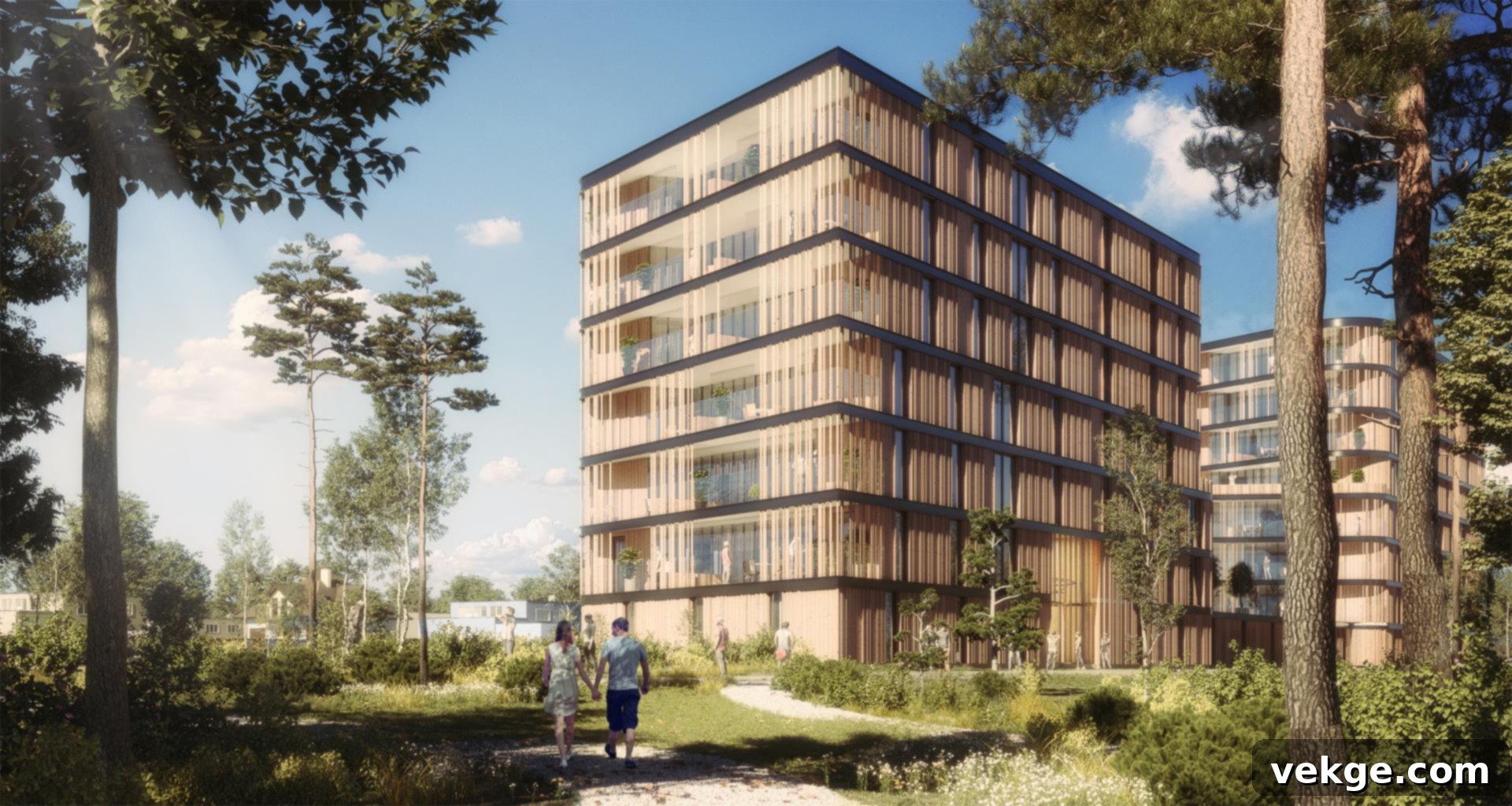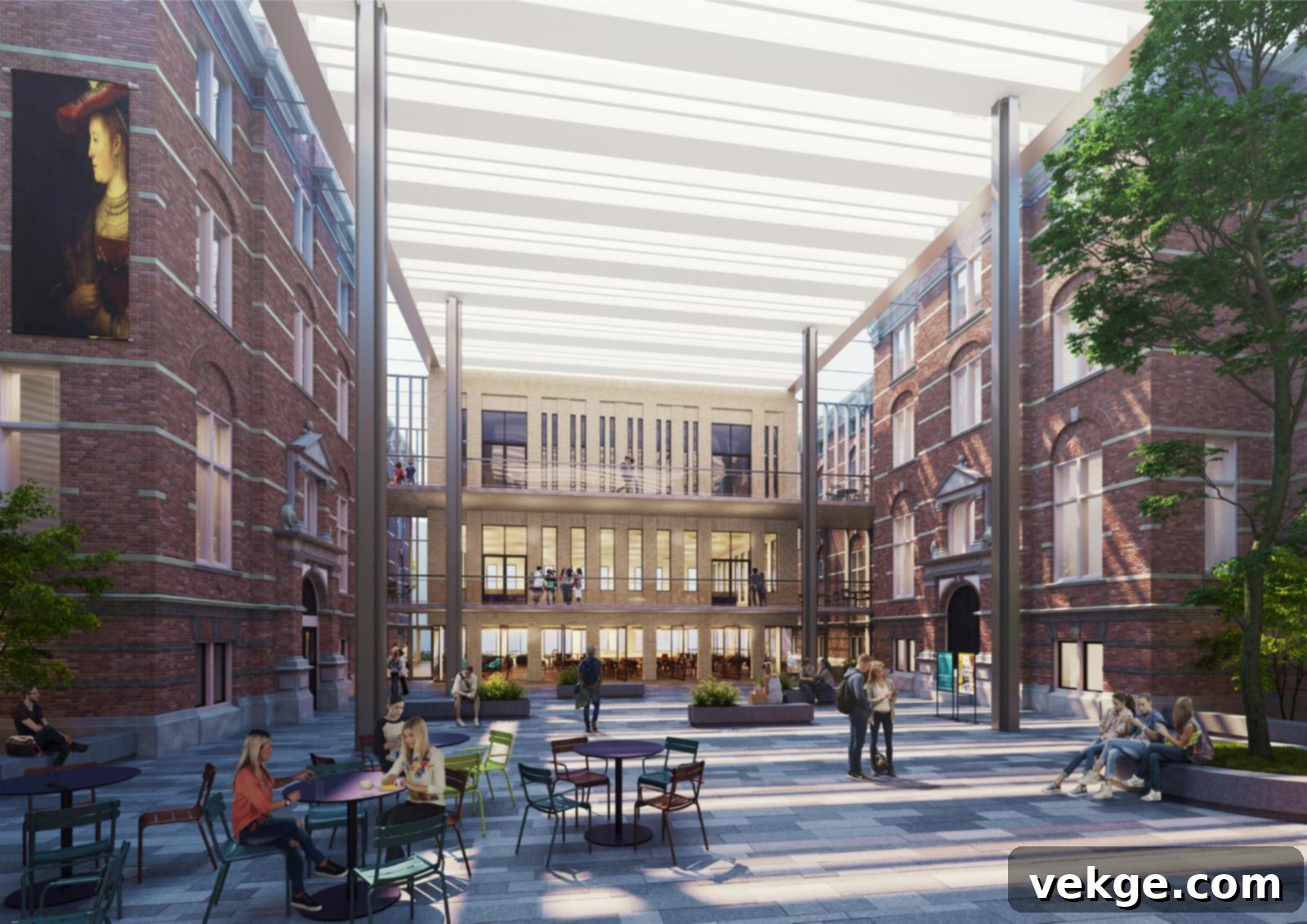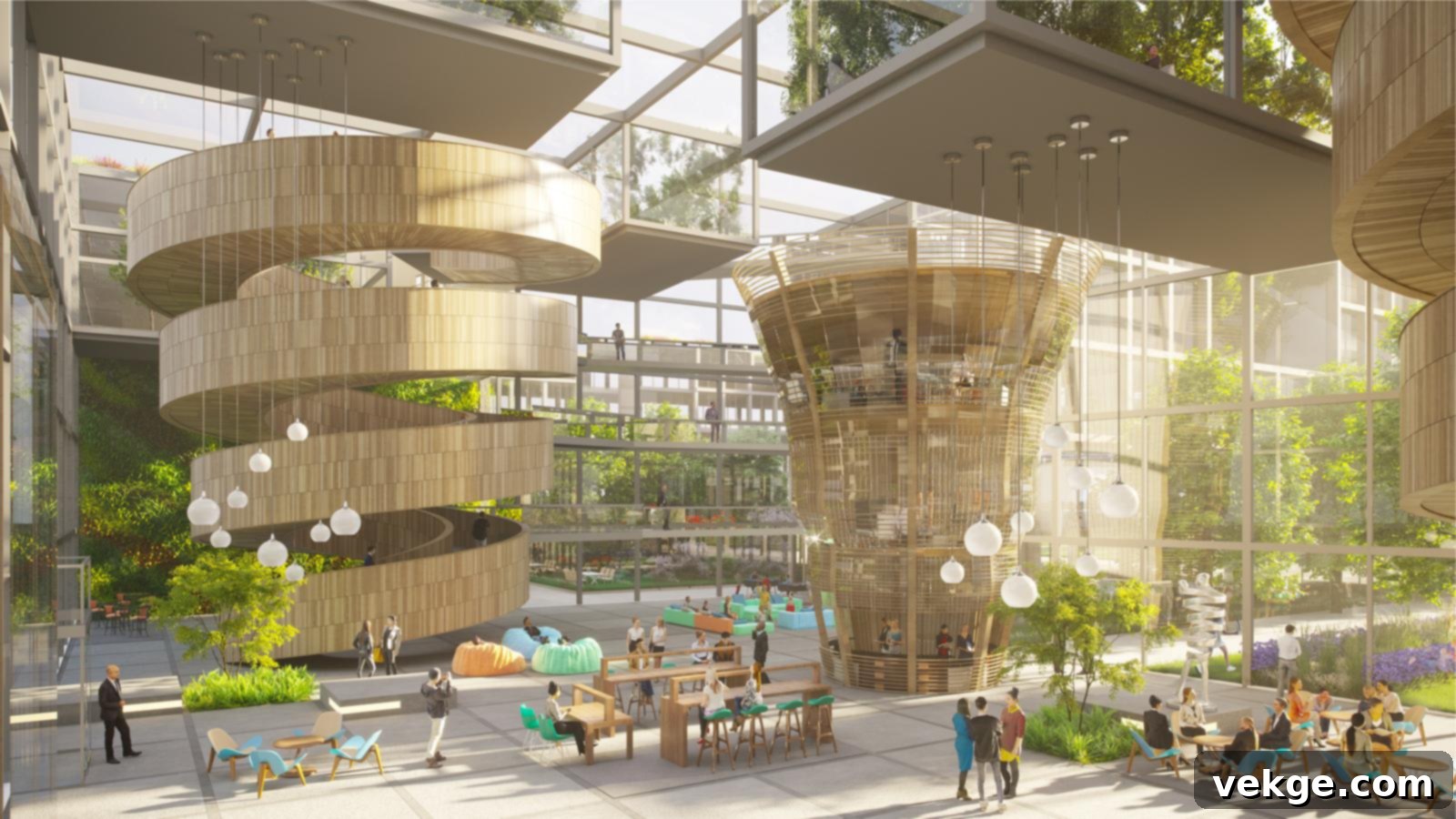In the rapidly evolving landscape of real estate, technology is no longer an optional add-on but a fundamental driver of innovation. One prime example of this transformative power is the stunning 3D interior rendering created by Render Art Studio for the Transpole Competition, showcasing a project presentation for 908 Avenue de la République, Marcq-en-Baroeul, France. This project exemplifies how advanced visualization tools are reshaping how properties are conceived, presented, and experienced.
The real estate industry is undergoing a profound technological metamorphosis, with tools like virtual reality (VR) and 3D rendering leading the charge. As demonstrated by the expertise of Render Art Studio, a leading 3D architectural rendering company, these innovations are fundamentally changing how properties are designed, developed, marketed, sold, and maintained. They are not merely enhancements but essential components of modern real estate strategies, pushing the boundaries of what’s possible and redefining industry standards.
Join us as we explore how these cutting-edge innovations are reshaping every facet of real estate, delving into the practical applications and strategic advantages they offer, and ultimately, why they represent the undeniable future of the industry.
Unlocking Real Estate’s Future: How Virtual Reality and 3D Rendering Are Revolutionizing the Industry
The Real Estate Industry’s Evolving Adoption of Technological Advancements
Historically, the real estate industry has often been characterized by its relatively slow adoption of technological advancements when compared to other sectors. This cautious approach has, at times, led to inefficiencies and missed opportunities.
Recent reports, such as Deloitte’s 2024 commercial real estate outlook, highlight this trend:
- A significant 61% of global real estate owners and investors continue to rely on legacy technology infrastructures, which can hinder agility and innovation.
- Alarmingly, up to 73% of enterprise data across various industries, including real estate, remains underutilized, representing a vast untapped resource for insights and strategic decision-making.

Image Source: Deloitte
However, despite a historically slow start, the real estate industry is now rapidly embracing Property Technology (Proptech). This powerful term broadly encompasses the integration of advanced technologies into various real estate processes and practices. Proptech solutions span a wide range of innovations, from sophisticated smart home developments that enhance living experiences to advanced online property viewing systems that simplify the buying and selling journey.
The global impact and growth of Proptech are undeniable. According to a comprehensive report by Grand View Research, the global Proptech market was valued at an impressive USD 25,145.1 million in 2021. Furthermore, it is projected to experience robust growth, with a compound annual growth rate (CAGR) of 15.8% from 2022 to 2030. This upward trend underscores the increasing recognition of technology’s vital role in optimizing operations, improving client experiences, and driving profitability within the real estate sector.
How Virtual Reality and 3D Rendering Are Revolutionizing Real Estate and Shaping Its Future

Architectural tender for Langeweg Hoek presented on renderings made by Render Art Studio, showcasing the power of architectural visualization.
Among the myriad of Proptech solutions gaining significant traction, virtual reality (VR) and 3D rendering stand out as two of the most widely adopted and impactful technologies embraced by forward-thinking real estate companies. These tools are fundamentally reshaping how we interact with and understand physical spaces, even before they are built.
Virtual reality (VR) is an immersive technology that creates a simulated environment, allowing users to fully immerse themselves in a three-dimensional, computer-generated space. By wearing a specialized VR headset, users can interact with this virtual environment in a remarkably realistic manner, mimicking real-life experiences such as walking through a property, opening doors, or even customizing interiors. This level of immersion provides an unprecedented sense of presence.
3D rendering, on the other hand, is the sophisticated process of generating highly realistic two-dimensional images or animations from a three-dimensional digital model. This technology is utilized to create compelling and narrative visualizations of objects, buildings, and spaces, showcasing their design, materials, and ambiance in exquisite detail. These renderings often serve as the first visual introduction to a property, setting high expectations for potential buyers and investors.
Let’s delve deeper into how these two powerful technologies are not just changing the industry, but actively shaping its future, providing competitive advantages across various real estate functions.
1. Transforming the Design and Planning Phase
Modern real estate development and construction now begin long before the first shovel breaks ground. Virtual reality and 3D rendering technologies have become indispensable tools, enabling architects, developers, and all project stakeholders to collaborate more effectively and intimately during the crucial planning and conceptualization stages. This enhanced collaboration streamlines communication and accelerates decision-making processes.
These powerful tools allow for highly detailed and interactive visualization of complex concepts. Teams can conduct virtual walkthroughs of proposed buildings, examine structural elements, assess material choices, and even simulate natural light conditions at different times of the day. This immersive experience helps identify potential design flaws, spatial conflicts, or aesthetic issues long before costly physical construction begins. By optimizing designs early on, developers can significantly reduce rework, save on material costs, and ensure that the final product aligns perfectly with the client’s vision and market demands. Furthermore, stakeholders can provide more informed feedback, leading to quicker approvals and a more efficient design iteration cycle.
2. Driving Marketing and Sales with Immersive Experiences
Virtual reality and 3D rendering are profoundly revolutionizing marketing and sales strategies in real estate, particularly for properties that are still in the pre-construction phase. These technologies provide immersive and highly interactive experiences that not only capture the immediate attention of potential buyers but also keep them deeply engaged throughout the sales journey, fostering a stronger emotional connection to the property.
Here’s how these technologies are transforming the marketing and sales landscape:
- Interactive Virtual Property Tours: These tours allow potential buyers to explore properties remotely from anywhere in the world, at any time. This capability saves significant time and travel costs for both buyers and agents, while simultaneously expanding market reach to a global audience. For pre-construction projects, buyers can virtually “walk through” their future home, experiencing the layout and ambiance firsthand, which is crucial for generating early interest and securing off-plan sales.
- Enhanced Visual Appeal and Storytelling: High-quality 3D renderings elevate property listings far beyond traditional photographs or blueprints. They transform static images into vibrant, realistic visualizations that highlight a property’s best features, showcase its potential, and tell a compelling story. This enhanced visual appeal makes listings more attractive and helps properties stand out prominently in an increasingly crowded and competitive real estate market.
- Customized Presentations and Personalization: Real estate agents can leverage VR and 3D tools to create highly tailored presentations that cater specifically to the individual needs and preferences of different clients. This might include virtual staging with various furniture styles, demonstrating different finish options, or even illustrating potential renovation possibilities. Such personalization significantly enhances the buying experience, making it more relevant and engaging for each prospective buyer.
- Faster Decision-Making and Reduced Buyer’s Remorse: The immersive and detailed visualizations provided by VR and 3D rendering empower buyers to make more informed decisions quickly and confidently. By truly understanding the space, its functionality, and aesthetic possibilities, buyers feel more secure in their choices. This often shortens the sales cycle, increases the likelihood of closing deals, and reduces instances of buyer’s remorse, leading to higher customer satisfaction.
- Early Buzz and Pre-Construction Sales: For new developments, VR and 3D renderings are invaluable for generating excitement and facilitating pre-construction sales. Developers can showcase entire projects—from individual units to communal spaces and amenities—long before they are physically built, allowing them to secure investments and tenants much earlier in the development lifecycle.
3. The Investment and Analysis Perspective
For investors, analysts, and financial institutions, virtual reality and 3D rendering technologies offer groundbreaking tools for property evaluation, risk assessment, and comprehensive portfolio management. These technologies provide an unparalleled level of detail and immersion that traditional methods, such as static blueprints or site visits alone, simply cannot match.
With the aid of VR and 3D rendering, investors can explore properties in profound depth, meticulously examining architectural details, floor plans, material finishes, and even projected views as if they were physically present on-site. This allows for a granular assessment of every aspect of a property, from the quality of construction to the potential for future modifications or upgrades. Such a high level of scrutiny is invaluable for accurately assessing possible risks, determining the true market value, and evaluating the long-term potential of an investment, ensuring that all decisions are based on the most comprehensive and accurate information available.
Beyond individual property assessment, investors can strategically use virtual reality and 3D rendering to create detailed visual representations of their entire property portfolio. This holistic and interactive view makes it significantly easier to manage multiple investments simultaneously, track their performance over time, and proactively identify opportunities for optimization or diversification. Moreover, these visual aids greatly facilitate better communication with stakeholders, co-investors, and financial partners, as visual data is often more accessible, persuasive, and easier to understand than traditional textual reports or spreadsheets, leading to more transparent and efficient investment discussions.
4. Improving Construction and Development Efficiency
The profound impact of virtual reality and 3D rendering technologies extends directly to the construction and development processes, ushering in an era of unprecedented efficiency, accuracy, and safety. These tools enable construction teams to move beyond traditional 2D plans, offering a dynamic and interactive view of projects.
Construction teams can now:
- Visualize complex structural elements in intricate detail: This includes understanding the placement of plumbing, HVAC systems, electrical conduits, and intricate steel structures, allowing for better coordination and reduced on-site errors.
- Coordinate with contractors and subcontractors more effectively: Virtual walkthroughs and shared 3D models ensure that all parties have a unified understanding of the project, facilitating seamless collaboration and preventing miscommunication.
- Track progress against 3D models in real-time: By integrating project schedules with 3D models (often referred to as 4D BIM), teams can monitor construction progress, identify delays, and manage resources more efficiently.
- Identify potential conflicts and clashes before they become costly issues: Advanced clash detection within 3D models can pinpoint where different building systems might interfere with each other, saving significant time and money on rework during construction.
- Make real-time adjustments to design elements and instantly see the impact: This agility allows for quick problem-solving and optimization, ensuring that the final build is as perfect as possible.
- Enhance construction safety training: VR provides immersive and realistic training environments where workers can practice dangerous scenarios, learn emergency procedures, and become familiar with complex machinery without any physical risk. This proactive approach significantly reduces accident rates on construction sites.
5. Enhancing Property Management and Maintenance
The realm of property management and maintenance has also been significantly transformed with the seamless integration of VR and 3D technology. These advanced tools empower building managers with capabilities that were previously unimaginable, leading to more proactive, efficient, and cost-effective operational strategies.
Using these technologies, building managers can:
- Access detailed 3D models of entire building systems: This includes comprehensive digital twins that accurately represent HVAC, plumbing, electrical, and security systems. Managers can quickly pinpoint locations of equipment, pipes, and wiring, drastically reducing diagnostic time for maintenance issues.
- Plan and schedule maintenance more effectively: By visualizing all assets and their locations in a 3D environment, managers can optimize maintenance routes, prioritize tasks, and allocate resources with greater precision, minimizing downtime and extending asset lifespans.
- Train staff using realistic virtual environments: New maintenance personnel can be onboarded and existing staff can undergo training for complex repairs or emergency procedures in a safe, simulated environment. This hands-on virtual experience builds confidence and competence without the risks or costs associated with real-world scenarios.
- Manage renovations and upgrades with greater precision: Before any physical work begins, managers can visualize proposed renovations in 3D, ensuring that designs are optimal, materials are correctly specified, and potential issues are identified and resolved virtually.
- Monitor building performance and energy efficiency: When integrated with IoT sensors, 3D models can become dynamic dashboards, providing real-time data on energy consumption, temperature, occupancy, and other critical metrics. This allows for proactive adjustments to improve efficiency and reduce operational costs.
- Improve tenant engagement and communication: Providing tenants with virtual guides to their building or unit, including troubleshooting tips presented in a 3D context, can enhance satisfaction and reduce the burden on property management staff.
Future Outlook: The Unstoppable March of Digital Real Estate

3D visualizations made for an architectural competition presenting a future university in Amsterdam, expertly created by Render Art Studio, highlighting future architectural visualization trends.
The shift toward virtual reality and 3D rendering in the real estate sector is an unstoppable force, propelled by rapidly evolving consumer expectations and relentless technological advancements. Today’s buyers demand greater transparency, convenience, and a more engaging experience. Simultaneously, developers and agents are continuously seeking innovative ways to differentiate themselves and capture market share in an increasingly competitive environment.
Looking ahead, we can anticipate even more significant and groundbreaking developments that will further entrench these technologies as cornerstones of the industry:
- Artificial Intelligence (AI) Integration: AI will revolutionize VR and 3D rendering by making these tools smarter, more personalized, and highly intuitive. We can expect AI to assist in automated design generation, predictive analytics for market trends within virtual spaces, and hyper-personalized property recommendations based on user interaction in VR tours.
- Augmented Reality (AR) Applications: AR will powerfully complement VR, offering new and practical ways to interact with and visualize real estate properties. Imagine using a smartphone or AR glasses to overlay virtual furniture into an empty physical room, visualize future renovations on an existing structure, or access real-time property data superimposed onto a building facade.
- Blockchain Integration for Property Records and Transactions: Blockchain technology is poised to offer more secure, transparent, and immutable methods for managing property records, conducting fractional ownership, and facilitating smart contracts for transactions. This will streamline processes, reduce fraud, and enhance trust in digital real estate dealings.
- Advanced Simulation Capabilities: Future advancements will bring even more detailed and accurate representations of properties. This includes environmental simulations (e.g., airflow, sunlight, noise pollution), structural integrity analyses, and even socio-economic impact simulations, providing developers and urban planners with unprecedented insights.
- Enhanced Collaborative Virtual Environments (Metaverse): Improved collaboration tools will extend beyond simple shared viewing. We envision metaverse-like environments where global teams of architects, engineers, clients, and investors can meet, design, review, and even negotiate property deals within a persistent, shared virtual space, breaking down geographical barriers.
With these transformative innovations on the horizon, there is no doubt that we are on the cusp of witnessing a significant evolution in how real estate is experienced and transacted in the future. It will be an industry that is decidedly more interactive, dramatically more efficient, and profoundly more buyer-focused, redefining the very essence of property ownership and investment.
Conclusion: Embracing the Digital Horizon of Real Estate
Virtual reality and 3D rendering are not just incremental improvements; they are truly transforming every single aspect of the real estate industry, from the initial architectural concept and design phase to ongoing property management and maintenance. These powerful technologies are doing more than merely enhancing existing processes; they are actively creating entirely new possibilities for development, investment strategies, marketing outreach, and the fundamental way we interact with real estate assets. Embracing these innovations is no longer an option but a necessity for any firm looking to thrive in the modern, digitally-driven real estate market.
Frequently Asked Questions About VR and 3D Rendering in Real Estate
1. What types of properties can benefit most from virtual reality and 3D rendering?
Virtual reality and 3D rendering are incredibly versatile and can offer significant benefits across a wide spectrum of property types. This includes residential homes (both existing and new builds), commercial buildings (offices, retail, industrial), large-scale new developments (master-planned communities, high-rises), and complex renovation or remodeling projects. Essentially, any property that can benefit from enhanced visualization, remote viewing, or immersive design exploration is an ideal candidate.
2. How is VR specifically being used in real estate construction safety training?
VR is revolutionizing construction safety training by providing immersive and risk-free environments. Construction workers can experience and practice dangerous scenarios, such as working at heights, operating heavy machinery, or responding to site emergencies, within a simulated virtual space. This hands-on, interactive training allows them to develop critical skills and situational awareness without any physical danger, significantly reducing on-site accidents and improving overall safety protocols.
3. Can smaller real estate firms genuinely benefit from investing in these technologies?
Absolutely. Even smaller real estate firms can leverage VR and 3D rendering to gain a significant competitive edge in the market. By offering enhanced customer experiences, such as virtual property tours or personalized 3D design visualizations, smaller firms can stand out from larger competitors. Many cost-effective solutions and third-party rendering services are available, allowing them to access these advanced tools without the prohibitive overheads associated with developing in-house capabilities.
4. What is the difference between Virtual Reality (VR) and Augmented Reality (AR) in real estate?
While both VR and AR enhance visualization, they do so differently. Virtual Reality (VR) creates a completely immersive, computer-generated environment that replaces the user’s real-world view (e.g., a full virtual tour of a property that doesn’t exist yet). Augmented Reality (AR), on the other hand, overlays digital information or virtual objects onto the user’s view of the real world (e.g., using a smartphone to place virtual furniture into an empty room you are physically standing in, or seeing property details pop up when you point your camera at a building).
